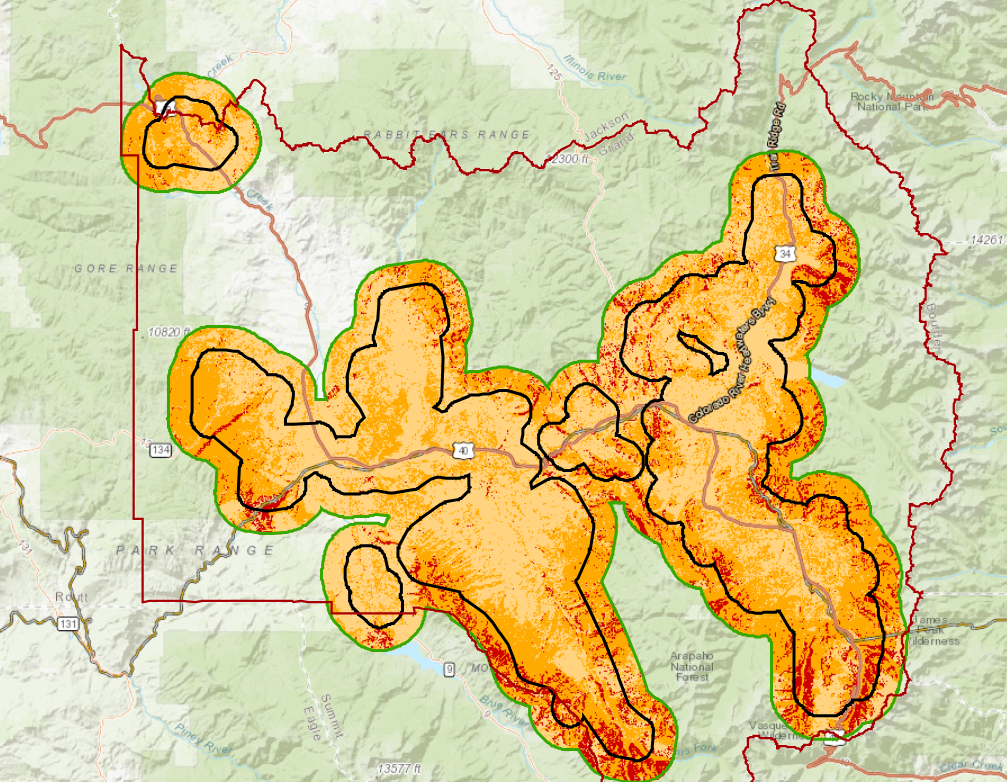WUI Best Practices
Wildland Urban Interface Best Practices in Grand County
Catastrophic fires have been a wake-up call to explore what we can do differently to reduce future losses from wildfire in the wildland urban interface (WUI). A WUI is composed of both interface and intermix communities and is defined as areas where human habitation and development meet or intermix with wildland fuels1. (Do I live in the WUI?)
We can better protect our homes and reduce the likelihood of life and property loss through home hardening techniques and by reducing vegetation and combustibles around the home and structures. Developing fire resistant homes and resilient infrastructure in the WUI can be difficult due to perceived costs, homeowner/ architect desires for aesthetics, and the lack of knowledge regarding resilient building and landscaping practices. Defensible space standards and WUI building codes may be misunderstood and therefore not embraced by homeowners in the WUI.
According to the Insurance Institute for Business & Home Safety2, during wildfires, as many as 90% of homes and buildings damaged or destroyed were first ignited by embers or other fires set by embers, and not the main wildland fire front. Home hardening techniques and reducing combustibles around the home can greatly reduce this risk.
Grand County’s Community Wildfire Protection Plan (CWPP) was updated in 20233. As part of that plan, updates to planning and development practices are recommended as essential wildfire risk management tools. Grand County Wildfire Council, in partnership with each of the Grand County fire districts, offers free wildfire risk home assessments that outline specific recommendations for homes to reduce a property owner’s risk in the event of a wildfire4.
Development of a fire adapted community includes:
- Best practice wildfire building codes, (sometimes referred to as WUI codes,) standards, and land-use practices that are used and enforced for new developments and rebuilding in wildfire-prone areas to make homes and businesses more ignition resistant, including retrofitting and mitigating existing structures5,
- Staff and volunteer fire departments who are funded, staffed, and equipped to respond safely and effectively to wildfire,
- Additional hazardous fuel and vegetation management reductions across both public and private lands to protect life safety, infrastructure, and individual homes, and,
- Public understanding of the roles and responsibilities of a fire adapted community including public action to reduce wildfire risk in and near their own homes.
GCWC provides public education and free home, property, and community wildfire risk assessments that include information on how to reduce your risk in the event of a wildfire. GCWC offers cost sharing reimbursement programs to reduce the cost of vegetation reduction and mitigation. GCWC can assist communities with becoming Firewise, which greatly reduces the communities risk in the event of a wildfire. Please go to bewilldfireready.org to sign up for more information today.
Grand County Wildfire Council (GCWC) is a non-profit, community-based education and mitigation program for the residents and visitors of Grand County, Colorado. Our group consists of members from local, state, and federal government agencies, our local fire departments, homeowner groups, local.
- U.S. Department of the Interior [USDI] and U.S. Department of Agriculture [USDA] 2001:752–753.
- 12 Mar 2019 Embers Cause Up to 90% of Home & Business Ignitions During Wildfire Events – Insurance Institute for Business & Home Safety (ibhs.org)
- Grand County Community Wildfire Protection Plan (arcgis.com)
- Free Home Assessment - Grand County Wildfire Council (bewildfireready.org)
- https://planningforhazards.com/wildland-urban-interface-code-wui-code
Click here to search your address on the Grand County WUI map, shown below.
